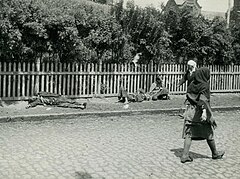
Back Holodomor AF هولودومور Arabic Holodomor AST Qolodomor AZ Украиналағы аслыҡ (1932—1933) BA Галадаморы (Украіна) BE Галадамор ва Ўкраіне BE-X-OLD Гладомор Bulgarian Holodomor BR Holodomor BS
| Holodomor Голодомор | |
|---|---|
 Starved peasants on a street in Kharkiv, 1933, Ukraine's capital at the time | |
| Country | Soviet Union |
| Location | Ukraine SSR, northern Kuban,[1] Kazakh ASSR |
| Period | 1932–1933 |
| Total deaths |
|
| Causes |
|
| Relief | Foreign relief rejected by the state. 176,200 and 325,000 tons of grains provided by the state as food and seed aids between February and July 1933.[5] |
| Consequences |
|
The Holodomor,[a] also known as the Ukrainian Famine,[8][9][b] was a human-made famine in Soviet Ukraine from 1932 to 1933 that killed millions of Ukrainians. The Holodomor was part of the wider Soviet famine of 1930–1933 which affected the major grain-producing areas of the Soviet Union.
While scholars are in consensus that the cause of the famine was man-made, it remains in dispute whether the Holodomor was directed at Ukrainians and whether it constitutes a genocide, the point of contention being the absence of attested documents explicitly ordering the starvation of any area in the Soviet Union. Some historians conclude that the famine was deliberately engineered by Joseph Stalin to eliminate a Ukrainian independence movement. Others suggest that the famine was primarily the consequence of rapid Soviet industrialisation and collectivization of agriculture. A middle position is that the initial causes of the famine were an unintentional byproduct of the process of collectivization but once it set in, starvation was selectively weaponized and the famine was "instrumentalized" and amplified against Ukrainians as a means to punish Ukrainians for resisting Soviet policies and to suppress their nationalist sentiments.
Ukraine was one of the largest grain-producing states in the USSR and was subject to unreasonably high grain quotas compared to the rest of the USSR in 1930.[10] [c] This caused Ukraine to be hit particularly hard by the famine. Early estimates of the death toll by scholars and government officials vary greatly. A joint statement to the United Nations signed by 25 countries in 2003 declared that 7 to 10 million died.[d] However, current scholarship estimates a range significantly lower with 3.5 to 5 million victims.[11] The famine's widespread impact on Ukraine persists to this day.[how?]
Public discussion of the famine was banned in the Soviet Union until the glasnost period initiated by Mikhail Gorbachev in the 1980s.[12] Since 2006, the Holodomor has been recognized by Ukraine, 33 other UN member states, and the European Parliament as a genocide against the Ukrainian people carried out by the Soviet government. In 2008, the Russian State Duma condemned the Soviet regime "that has neglected the lives of people for the achievement of economic and political goals".[13]
- ^ Naimark 2010, p. 70.
- ^ Osadchenko & Rudneva 2012.
- ^ Boeck, Brian J. (30 October 2023). "Complicating the National Interpretation of the Famine: Reexamining the Case of Kuban". Harvard Ukraine Studies. 30 (1/4): 48. JSTOR 23611465.
- ^ a b Ohayon 2016.
- ^ Davies & Wheatcroft 2004, pp. 479–484.
- ^ Ellman 2007.
- ^ Jones 2017, p. 90.
- ^ "How Joseph Stalin Starved Millions in the Ukrainian Famine". HISTORY. 16 April 2019. Retrieved 13 February 2024.
- ^ Renate, Stark. "Holodomor, Famine in Ukraine 1932-1933: A Crime against Humanity or Genocide?". Irish Journal of Applied Social Studies: Vol. 10: Iss. 1, Article 2. doi:10.21427/D7PQ8P. Retrieved 14 September 2024.
- ^ Cite error: The named reference
Kulchytskystalinslavewas invoked but never defined (see the help page). - ^ Gorbunova & Klymchuk 2020; Kravchenko 2020; Marples 2007, p. 1; Mendel 2018; Yefimenko 2021
- ^ Serbyn 2005, pp. 1055–1061.
- ^ National Museum of the Holodomor 2019.
Cite error: There are <ref group=lower-alpha> tags or {{efn}} templates on this page, but the references will not show without a {{reflist|group=lower-alpha}} template or {{notelist}} template (see the help page).